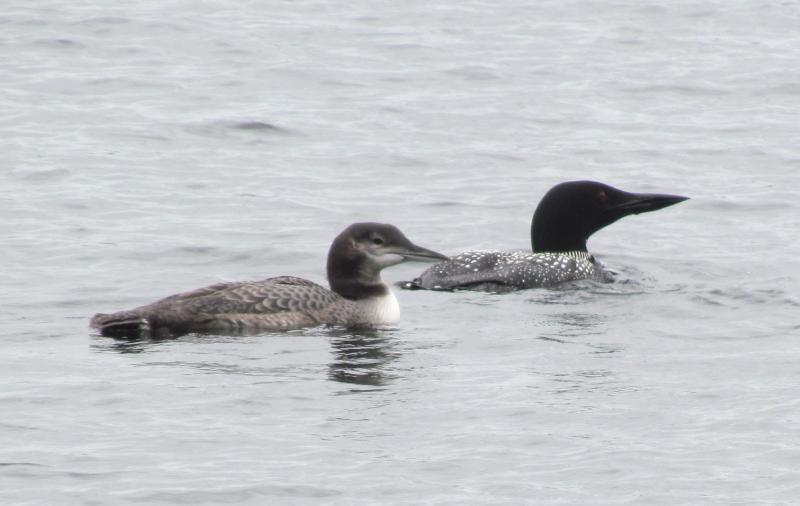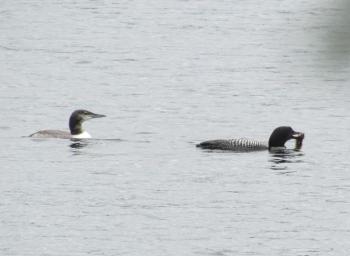A few weeks ago, sister-in-law Nina called from camp to get our opinion. A loon was lolling about near shore at the lake, looking a bit unkempt and flailing its legs about. She was rightly concerned that the bird might be injured or caught in some fishing line like the one she had rescued a few years back. From some photos and video that she sent, we were able to discern that the bird in question, though as large as an adult, was a young bird, hatched this summer. Soon after that, she saw two adult loons feeding the youngster crayfish and small minnows. The local game warden suggested that she keep an eye on it but that it sounded like it might just be a young bird still learning how to be a loon.
Last week, we had the good fortune to be able to spend a few days at the camp as well, and we were excited to see that same young loon hanging out with its parents, especially one adult that we guessed might be its mother. The youngster was looking robust, and we were thrilled to finally see it peering into the water and fully diving—a behavior that Nina had not seen it engage in yet.
One day, we watched for some time the two parents with their offspring. The adult that we had decided (rightly or wrongly) was the mom, brought small fish over to the young loon but wouldn’t give it over immediately. A few times, she kept the fish and made a shallow dive nearby as though trying to get the youngster to try to get the fish underwater. Who knows if our interpretation of what was going on was right, but it would seem to be a sensible way to teach a young loon how to begin learning how to catch fish.
While all this was going on with the loon family, an all-brown, young-of-the-year bald eagle gave its screechy, complaining calls throughout the day from a small spruce and pine-covered island just offshore. While we watched, it showed no indication that it had learned how to hunt or scavenge but instead seemed to just be hoping its loud calls would bring one of its parents back to the nesting island to feed it. Was this normal parenting for eagles? Was the adult trying to get the young birds to begin moving away from the familiar and start some early clumsy foraging attempts?
We had some indication of the return of an adult bald eagle to the area because the adult loons would give their loud cries whenever one came anywhere nearby. On the other hand, they ignored the young eagle and would feed quite near to it without showing signs of alarm.
And while some birds like these loons and eagles are still finishing the job of raising their young, lots of birds from farther north are migrating through our area. Just this weekend we had a small flock of migrating warblers in the yard, common nighthawks dashing through the sky, and a single least sandpiper passed over, giving its high “cree” call repeatedly.
The rhythms of life on earth sure are beautiful and amazing. We hope you are enjoying them, too.
Jeffrey V. Wells, Ph.D., is a Fellow of the Cornell Lab of Ornithology and Vice President of Boreal Conservation for National Audubon. Dr. Wells is one of the nation's leading bird experts and conservation biologists. He is a coauthor of the seminal “Birds of Maine” book and author of the “Birder’s Conservation Handbook.” His grandfather, the late John Chase, was a columnist for the Boothbay Register for many years. Allison Childs Wells, formerly of the Cornell Lab of Ornithology, is a senior director at the Natural Resources Council of Maine, a nonprofit membership organization working statewide to protect the nature of Maine. Both are widely published natural history writers and are the authors of the popular books, “Maine’s Favorite Birds” (Tilbury House) and “Birds of Aruba, Bonaire, and Curaçao: A Site and Field Guide,” (Cornell University Press).































.png)
.png)

